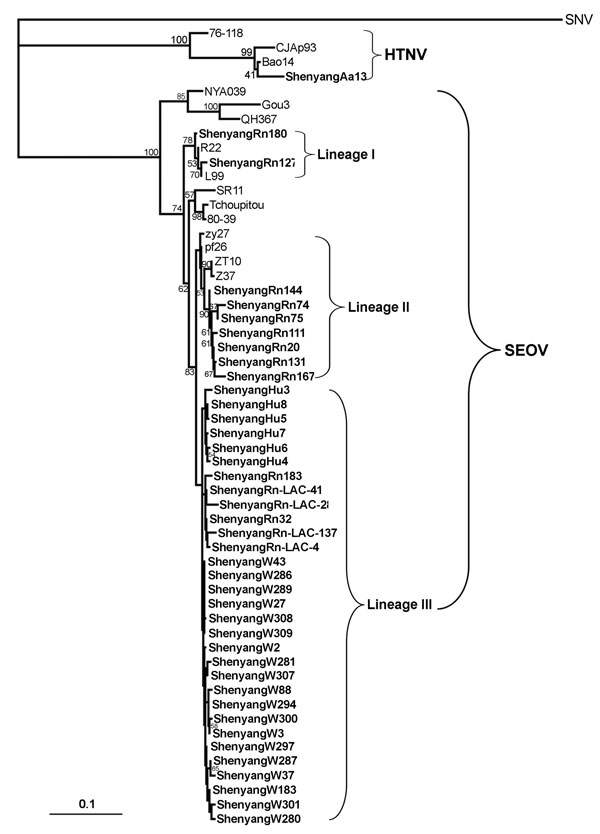Volume 15, Number 2—February 2009
Research
Seoul Virus and Hantavirus Disease, Shenyang, People’s Republic of China
Figure 2

Figure 2. Phylogenetic tree of hantaviruses based on partial sequences of the small (S) segment (nt 600–999 for Seoul virus (SEOV) and nt 514–1026 for hantaan virus (HTNV). PHYLIP program package (3.65) was used to construct the phylogenetic trees by using the neighbor-joining (NJ) method and the maximum likehood (ML) with 1,000 replicates. The tree, constructed by using the ML method, had a similar topology as that constructed by the NJ method (data not shown). Bootstrap values were calculated from 1,000 replicates; only values >50% are shown at the branch nodes. The sequence of Sin Nombre virus (SNV) was used as an outgroup. Partial S-segment sequences recovered from 6 patient serum samples were designated ShenyangHu3, ShenyangHu4, ShenyangHu5, ShenyangHu6, ShenyangHu7, and ShenyangHu8. Sequences from Rattus norvegicus trapped in 2006 in the vicinity of the Laboratory Animal Center of Shenyang Pharmaceutical University were designated ShenyangRn-LAC-4, ShenyangRn-LAC-28, and ShenyangRn-LAC-41. ShenyangRn-LAC-137, from R. norvegicus and A. agrarius, trapped in 2006–2007 in the major hemorrhagic fever with renal syndrome–endemic focus in the rural areas of Shenyang were designated ShenyangRn20, ShenyangRn32, ShenyangRn74, ShenyangRn75, ShenyangRn111, ShenyangRn127, ShenyangRn131, ShenyangRn144, ShenyangRn167, ShenyangRn180, ShenyangRn183, and ShenyangAa13), from hantavirus antigen–positive laboratory rats were designated ShenyangW–. Sequences obtained in this study are shown in boldface. The GenBank accession numbers of the other partial S segment sequences are SNV/NM H10 (L25748); HTNV/76–118 (M14626), HTNV/CJAp93 (EF208953), HTNV/Bao14 (AB127998); SEOV/NYA039 (EF210131), SEOV/Gou3 (AF288651), SEOV/QH367 (DQ081717), SEOV/SR11 (M34881), SEOV/Tchoupitoulas (AF329389), SEOV/80–39 (AY273791), SEOV/L99 (AF488708), SEOV/R22 (AF488707), SEOV/pf26 (AY006465), SEOV/zy27 (AF406965), SEOV/Z37 (F187082), and SEOV/ZT10 (AY766368). Scale bar represents genetic distance.